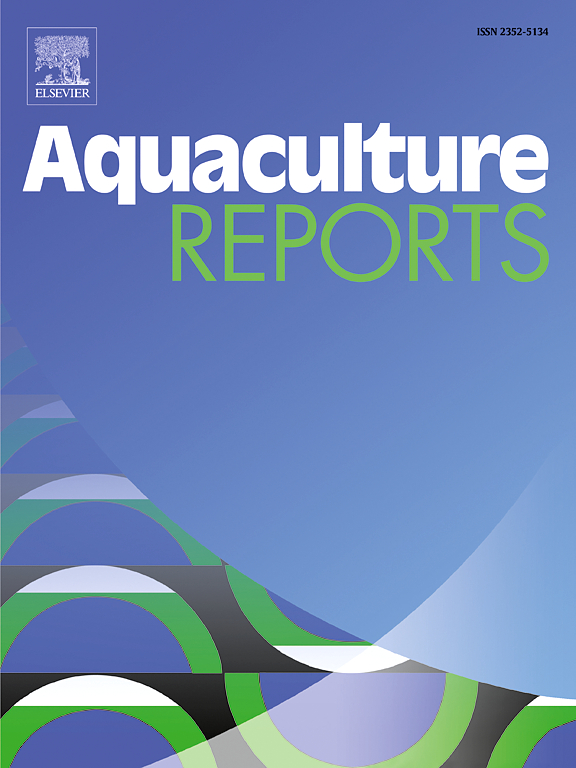母鱼补充纳米硒通过影响基因表达和生理参数来提高亚洲海鲈(Lates calcarifer)的繁殖结果和幼虫质量
IF 3.7
2区 农林科学
Q1 FISHERIES
引用次数: 0
摘要
硒在脊椎动物的抗氧化防御、免疫功能和生殖生理中起着重要作用。本研究通过影响基因表达、抗氧化能力、激素水平和生殖指标,评估了饲料中硒纳米颗粒(SeNPs)对亚洲海鲈(Lates calcarifer)雌性繁殖结局、甾体生成、卵黄形成和幼虫质量的影响。雌亲鱼(n = 12;分别饲喂基础饲粮(对照)和基础饲粮中添加2 mg SeNPs/kg (SeNPs-2)的试验组,试验期为产卵前120 d。添加SeNPs显著(P <; 0.05)增加了肝脏、卵巢和幼虫中的硒沉积,增强了抗氧化能力(谷胱甘肽过氧化物酶和还原性谷胱甘肽),降低了氧化应激标志物(丙二醛;在亲鱼和后代中都有MDA)。SeNPs-2组卵巢和肝脏中与甾体形成相关的基因(star、P450scc和3β-hsd)和卵黄形成相关的基因(zp2和vtg)表达水平上调(P <; 0.05)。尽管血清睾酮和雌二醇水平相当(P >; 0.05),但饲喂SeNPs-2饲料的鱼的黄体酮水平、血清胆固醇和甘油三酯水平显著降低(P <; 0.05)。SeNPs-2组的产卵频率、相对繁殖量、受精率和孵化率均显著提高(P <; 0.05)。与对照组相比,经senps喂养的亲鱼后代生长促进基因(GH和IGF-I)表达量更高,体型更大,发育性状更好。综上所述,饲粮中添加SeNP可显著影响钙化乳虾硒的生物利用度、基因表达、繁殖效率和幼虫品质。SeNPs是一种很有前途的营养策略,可用于优化亲鱼生产性能和提高水产养殖后代质量。本文章由计算机程序翻译,如有差异,请以英文原文为准。
Maternal supplementation with selenium nanoparticles enhances reproductive outcomes and larval quality in Asian seabass (Lates calcarifer) by influencing gene expression and physiological parameters
Selenium plays vital roles in antioxidant defense, immune function, and reproductive physiology in vertebrates. This study evaluated the impacts of dietary selenium nanoparticles (SeNPs) on reproductive outcomes, steroidogenesis, vitellogenesis, and larval quality in female Asian seabass (Lates calcarifer), by influencing gene expression, antioxidant capacity, hormone levels, and reproductive indices. Female broodfish (n = 12; 1990 ± 120 g) were fed either a basal diet (control) or a basal diet supplemented with 2 mg SeNPs/kg (SeNPs-2) for 120 days before spawning. Supplementation with SeNPs significantly (P < 0.05) increased Se deposition in the liver, ovary, and larvae, enhancing antioxidant capacity (glutathione peroxidase and reduced-glutathione), and reducing oxidative stress marker (malondialdehyde; MDA) in both broodfish and offspring. The expression levels of genes involved in steroidogenesis (star, P450scc, and 3β-hsd) and vitellogenesis (zp2 and vtg) were upregulated in the ovary or liver of the SeNPs-2 group (P < 0.05). Despite comparable serum testosterone and estradiol levels (P > 0.05), broodfish fed the SeNPs-2 diet exhibited significantly (P < 0.05) lower progesterone levels, and lower serum cholesterol and triglyceride levels. Reproductive performance, as indicated by spawning frequency, relative fecundity, fertilization rate, and hatching rate, was significantly (P < 0.05) improved in the SeNPs-2 group. Larvae descending from the SeNPs-fed broodfish exhibited higher expression of growth-promoting genes (GH and IGF-I), larger body size, and better developmental traits than those from the control group. These findings suggest that dietary SeNP supplementation positively influences Se bioavailability, gene expression, reproductive efficiency, and larval quality in L. calcarifer. SeNPs represent a promising nutritional strategy for optimizing broodstock performance and enhancing offspring quality in aquaculture.
求助全文
通过发布文献求助,成功后即可免费获取论文全文。
去求助
来源期刊

Aquaculture Reports
Agricultural and Biological Sciences-Animal Science and Zoology
CiteScore
5.90
自引率
8.10%
发文量
469
审稿时长
77 days
期刊介绍:
Aquaculture Reports will publish original research papers and reviews documenting outstanding science with a regional context and focus, answering the need for high quality information on novel species, systems and regions in emerging areas of aquaculture research and development, such as integrated multi-trophic aquaculture, urban aquaculture, ornamental, unfed aquaculture, offshore aquaculture and others. Papers having industry research as priority and encompassing product development research or current industry practice are encouraged.
 求助内容:
求助内容: 应助结果提醒方式:
应助结果提醒方式:


